In the College of Arts and Sciences, there are always big things happening. Take a look at some of our highlights from August 2016:
Biochemistry and Molecular Biophysics
Gender, Women, and Sexuality Studies
Journalism and Mass Communications
Sociology, Anthropology, and Social Work
Biochemistry and Molecular Biophysics
Michael Kanost, university distinguished professor of biochemistry and molecular biophysics, led a team of 114 researchers from 50 institutions and 11 countries in a project to sequence and annotate the genome of the tobacco hornworm — a caterpillar species used in many research laboratories for studies of insect biology. The researchers have published their work “Multifaceted biological insights from a draft genome sequence of the tobacco hornworm moth, Manduca sexta” in the journal Insect Biochemistry and Molecular Biology and have made the genome sequence available to the public through the National Agricultural Library.
“This project represents years of collaborative research across the world,” said Kanost, who studies insect immune systems. “We wanted to provide these valuable data to scientists, and our hope is that this sequenced genome will stimulate new research in molecular studies of insects.”
The tobacco hornworm, or Manduca sexta, develops into the Carolina sphinx moth. The name Manduca comes from the Latin word for glutton because these caterpillars eat so much. Manduca sexta occurs naturally in North, Central and South America and is a known pest to gardeners: It eats the leaves of tomato plants and also can be found on pepper, eggplant and potato plants. Crops and weeds from this plant family, which includes tobacco, produce chemicals such as nicotine that deter feeding by most insects, but not Manduca sexta, which makes its physiology especially interesting to scientists. The sequenced genome can lead to improved molecular biology, physiology and neurobiology research in insects and also may help in developing future new methods for insect pest management.
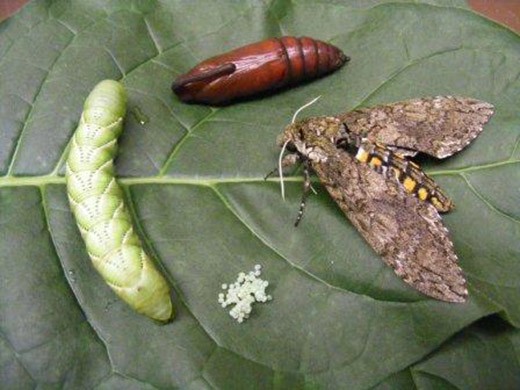
Kanost has studied the tobacco hornworm for decades, and he and Gary Blissard, from the Boyce Thompson Institute at Cornell University, decided to start the collaborative project to sequence the tobacco hornworm’s genome in 2009. Kanost’s research focuses on proteins in caterpillar’s blood and how insects protect themselves against infections. Kanost and the Kansas State University research team prepared and purified the DNA of the tobacco hornworm and sent the samples to the Baylor College of Medicine Human Genome Sequencing Center in Houston, which performed the genome sequencing. The international team used a common computer system so that the researchers from around the world could analyze the gene sequences based on their areas of expertise.
Other Kansas State University researchers involved in the project included Susan Brown, university distinguished professor of biology; Rollie Clem, professor of biology; William Bryant, research assistant professor in biology; Neal Dittmer, research assistant professor of biochemistry and molecular biophysics; Subbaratnam Muthukrishnan, university distinguished professor emeritus of biochemistry and molecular biophysics; Lorena Passarelli, professor of biology; Yoonseong Park, professor of entomology; Nicolae Herndon, doctoral graduate in computer science; Jayne Christen, doctoral graduate and former postdoctoral research associate in biochemistry and molecular biophysics; and Di Wu, former postdoctoral research associate in biochemistry and molecular biophysics. The project received financial support from the National Institutes of Health (Kanost) and the Defense Advanced Research Projects Agency, or DARPA (Blissard). Return to top
Biology
Walter Dodds, university distinguished professor of biology, was named an inaugural fellow of the Society for Freshwater Science.
Dodds is recognized for his contributions to freshwater science, promoting freshwater science through education and outreach and membership in the society. The society’s board of directors selected fellows for the inaugural class.
The society is an international scientific organization that promotes further understanding of freshwater ecosystems — rivers, streams, wetlands and lakes — and ecosystems at the interface between aquatic and terrestrial habitats, such as streamside vegetation. Dodds will be recognized and inducted into the inaugural class of fellows at the society’s annual meeting, June 4-9, 2017, in Raleigh, North Carolina. Return to top
English
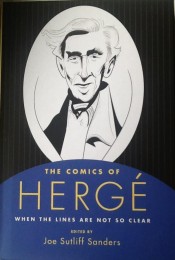 Joe Sutliff Sanders, associate professor of English, published two edited collections: “The Comics of Herge: When the Lines Are Not So Clear” (UP of Mississippi, 2016) and, with colleague Michelle Ann Abate, “Good Grief! Children’s Comics, Past and Present” (Ohio State University Libraries, 2016).
Joe Sutliff Sanders, associate professor of English, published two edited collections: “The Comics of Herge: When the Lines Are Not So Clear” (UP of Mississippi, 2016) and, with colleague Michelle Ann Abate, “Good Grief! Children’s Comics, Past and Present” (Ohio State University Libraries, 2016).
Sanders also published essays in each collection: “Herge’s Occupations: How the Creator of Tintin Made a Deal with the Devil and Became a Better Cartoonist” and “How Comics Became Kids’ Stuff.” Return to top
Gender, Women, and Sexuality Studies
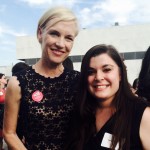 Haley Kottler, senior dual-degree candidate in Gender, Women, and Sexuality Studies and Family Studies and Human Development interned this summer in Washington, DC with EMILY’s List, a nationwide organization that works to elect pro-choice, Democratic women to office. She is currently the Reproductive Justice Coordinator for an on-campus organization called Feminists Igniting Resistance and Empowerment, as well as an Ambassador for the Gender, Women and Sexuality Studies department. Haley recently accepted a part-time position as Campaign Headquarters Manager for the Riley County Democratic Party. Haley says that “through my courses at KSU, I realized that the path to igniting change in our great state is by getting open-minded, productive leaders in the state legislature who will fight for our Kansas values – and I wanted to help achieve that goal!”
Haley Kottler, senior dual-degree candidate in Gender, Women, and Sexuality Studies and Family Studies and Human Development interned this summer in Washington, DC with EMILY’s List, a nationwide organization that works to elect pro-choice, Democratic women to office. She is currently the Reproductive Justice Coordinator for an on-campus organization called Feminists Igniting Resistance and Empowerment, as well as an Ambassador for the Gender, Women and Sexuality Studies department. Haley recently accepted a part-time position as Campaign Headquarters Manager for the Riley County Democratic Party. Haley says that “through my courses at KSU, I realized that the path to igniting change in our great state is by getting open-minded, productive leaders in the state legislature who will fight for our Kansas values – and I wanted to help achieve that goal!”
Gabriela Díaz de Sabatés, assistant professor in the Gender, Women, and 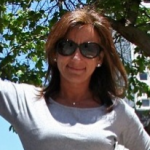 Sexuality Studies Department, presented “Speaking the Unspeakable: Women, Feminism, and State Terrorism in Argentina in the 1970s and 1980s” at the 2016 Mujeres Activas en Letras y Cambio Social, or MALCS, Summer Institute Aug. 3-6 at the University of Wyoming, Laramie. The institute’s theme was “Deconstructing the Equality State: Remnants of Colonialism, Trauma, and Invisibility.” Sabatés’ research is based on interviews with Argentinian women and relates to her interestes in women’s life narratives and Latin American feminisms.
Sexuality Studies Department, presented “Speaking the Unspeakable: Women, Feminism, and State Terrorism in Argentina in the 1970s and 1980s” at the 2016 Mujeres Activas en Letras y Cambio Social, or MALCS, Summer Institute Aug. 3-6 at the University of Wyoming, Laramie. The institute’s theme was “Deconstructing the Equality State: Remnants of Colonialism, Trauma, and Invisibility.” Sabatés’ research is based on interviews with Argentinian women and relates to her interestes in women’s life narratives and Latin American feminisms.
Assistant Professor Harlan Weaver traveled to Stockholm, Sweden in June 2016 in order to participate in the annual meeting of the European Society for Literature, Science, and the Arts, the theme of which was Control. Funded by an FDA travel grant, Professor Weaver’s conference paper, “Both Ends of the Leash: Training, Embodied Empathy, 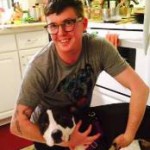 and Responding in Kind,” part of a panel on “response-abilities” that examined the roles of ethics and responsiveness in human-animal relationships, focused on the role of embodied understanding, or empathy, in contemporary dog training practices. Asking how to reconcile epistemologies rooted in bodies as ways of thinking through human-specific differences such as race, gender, class, sexuality, and nation with training practices that emerge from cross-species bodily knowledges involving, for example, how to move like a dog, Weaver’s invited paper contributed to rich dialogues among conference participants on how to connect human-animal studies in the humanities with critical race theories and gender and sexuality studies. Return to top
and Responding in Kind,” part of a panel on “response-abilities” that examined the roles of ethics and responsiveness in human-animal relationships, focused on the role of embodied understanding, or empathy, in contemporary dog training practices. Asking how to reconcile epistemologies rooted in bodies as ways of thinking through human-specific differences such as race, gender, class, sexuality, and nation with training practices that emerge from cross-species bodily knowledges involving, for example, how to move like a dog, Weaver’s invited paper contributed to rich dialogues among conference participants on how to connect human-animal studies in the humanities with critical race theories and gender and sexuality studies. Return to top
Geography
Francesco Orsi, Assistant Professor, was interviewed about sustainable transportation in America’s national parks by the US edition of the British newspaper The Guardian for an issue on sustainable transportation in national parks. Sustainable tra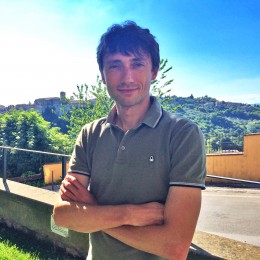 nsportation is one of the top priorities set by the National Park Service during it 100th birthday celebration year. Dr. Orsi is widely recognized as an authority on sustainable transportation in natural and protected areas. His research emphasizes the importance of balancing private and alternative transportation in parks and other protected natural areas.
nsportation is one of the top priorities set by the National Park Service during it 100th birthday celebration year. Dr. Orsi is widely recognized as an authority on sustainable transportation in natural and protected areas. His research emphasizes the importance of balancing private and alternative transportation in parks and other protected natural areas.
Jida Wang, Assistant Professor, gave an invited lecture titled “Advancement of Understanding Terrestrial Water Storage in the Anthropocene” at the Institute of 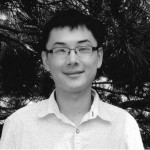 Remote Sensing and Digital Earth of the Chinese Academy of Sciences in Beijing. Dr. Wang’s talk focused on terrestrial water storage (TWS) and the critical role it plays in understanding the global water budget. He stressed that monitoring TWS is a crucial sentinel of global environmental change. Dr. Wang is at the forefront of monitoring and modelling global freshwater reserves using remote sensing and other geospatial technologies. Return to top
Remote Sensing and Digital Earth of the Chinese Academy of Sciences in Beijing. Dr. Wang’s talk focused on terrestrial water storage (TWS) and the critical role it plays in understanding the global water budget. He stressed that monitoring TWS is a crucial sentinel of global environmental change. Dr. Wang is at the forefront of monitoring and modelling global freshwater reserves using remote sensing and other geospatial technologies. Return to top
Geology
The first of a proposed network of soil monitoring arrays was installed on Konza Prairie on Aug. 29-30. The array allows high-resolution measurements of soil temperature, moisture and matric potential, and also enables the sampling of pore gas and water for chemical analysis. This new infrastructure will support  future prairie research by Kansas State University, and is an important step towards establishing a comprehensive characterization of the hydrology of the region. The project is an ongoing, interdisciplinary collaboration between the departments of geology, geography, agronomy and engineering, and partners at the University of Kansas and Kansas Geological Survey. The installation was led by post-doctoral researcher Sara Vero (Dept. of Geology), who was joined by Professor Ransom (Dept. of Agronomy) and graduate students Colleen Gura and Forest Shepherd (Dept. of Geology). Return to top
future prairie research by Kansas State University, and is an important step towards establishing a comprehensive characterization of the hydrology of the region. The project is an ongoing, interdisciplinary collaboration between the departments of geology, geography, agronomy and engineering, and partners at the University of Kansas and Kansas Geological Survey. The installation was led by post-doctoral researcher Sara Vero (Dept. of Geology), who was joined by Professor Ransom (Dept. of Agronomy) and graduate students Colleen Gura and Forest Shepherd (Dept. of Geology). Return to top
Journalism and Mass Communications
The A.Q. Miller School of Journalism and Mass Communications was well represented at the annual conference of the Association for Education in Journalism and Mass Communication in Minneapolis, Aug. 3 through Aug. 7, 2016. Here are some highlights from the conference:
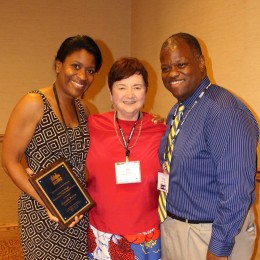 Professor Kimetris Baltrip was selected to receive the 2016 Robert Knight Multicultural Recruitment Award on Aug. 6. This award, created in 1987, is presented annually by the Scholastic Journalism and Minorities and Communication divisions to organizations or individuals who have made outstanding efforts in attracting high school minority students into journalism and mass communication. [Pictured: Prof. Baltrip with Assoc. Dean for Academic Affairs Louise Benjamin and previous Knight award winner George Daniels.]
Professor Kimetris Baltrip was selected to receive the 2016 Robert Knight Multicultural Recruitment Award on Aug. 6. This award, created in 1987, is presented annually by the Scholastic Journalism and Minorities and Communication divisions to organizations or individuals who have made outstanding efforts in attracting high school minority students into journalism and mass communication. [Pictured: Prof. Baltrip with Assoc. Dean for Academic Affairs Louise Benjamin and previous Knight award winner George Daniels.]
Professor Bonnie Bressers and David “Bondy” Kaye, a JMC graduate student, presented a paper titled “Youth Participating in Civic Engagement: ‘Doing that Volunteering Stuff’ at the Kiowa County Media Center” in a scholar-to-scholar session at the conference. Other JMC co-authors were Sam Mwangi and Steve Smethers.
Xiaochen “Angela” Zhang presented her paper “Understanding Publics’ Post-Crisis Social Media Engagement” in a scholar-to-scholar session.
Department Director Birgit Wassmuth facilitated a half-day workshop at the convention on the topic “Teaching online Media and Diversity classes: Pitfalls and Unique Opportunities.” The panelists discussed critical challenges, including how to deal with sensitive instructor experiences; ways to use social media in class; U.S social history awareness challenges for international students; teaching traditional 15-week vs. accelerated 7-week course modules; class size impact (from modest enrollment to MOOCs); “Killing the messenger” influence on teacher evaluations; elective vs. required course factors; and administrative support -or lack thereof. This workshop was cosponsored by the Minorities and Communication Division and the Commission on the Status of Women.
 Andrew “Drew” Smith hosted two half-hour Packers specials titled “The Fox 11 Training Camp Report.” One was a live remote broadcast from Santa Clara, California, which aired Aug. 25. The other was live from Kansas City on Aug. 31. He also appeared as a guest on WDUZ-FM in Green Bay on the show “Green Bay GameDay” prior to the games. Smith recently left his long-time post at Fox 11 to teach full time at K-State. You can view his on-air goodbye here. Return to top
Andrew “Drew” Smith hosted two half-hour Packers specials titled “The Fox 11 Training Camp Report.” One was a live remote broadcast from Santa Clara, California, which aired Aug. 25. The other was live from Kansas City on Aug. 31. He also appeared as a guest on WDUZ-FM in Green Bay on the show “Green Bay GameDay” prior to the games. Smith recently left his long-time post at Fox 11 to teach full time at K-State. You can view his on-air goodbye here. Return to top
Modern Languages
Assistant professors of German Sara Luly and Janice McGregor conducted a site visit to Ludwig-Maximilians University in Munich and Justus-Liebig University in Giessen, universities with which Kansas State has longstanding exchange agreements and German study abroad programs. This trip was funded by an International Incentive Grant.
During these visits, Luly and McGregor met with colleagues in the German departments and university international offices to learn how K-State students find, select, enroll and complete classes as well as the system with which transcripts are compiled. In addition, they toured student housing and lecture halls; met with professors; and visited campus dining in order to get a better idea of how K-State students live at these universities while abroad. These visits offered K-State faculty a valuable opportunity to learn about local advising and to share recruitment ideas with German colleagues face-to-face.
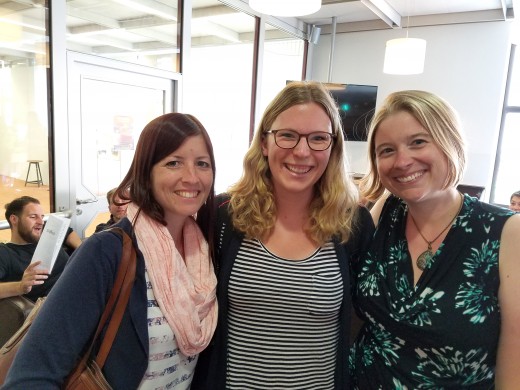
To find out more about K-State German language exchange programs, contact srluly@ksu.edu or jmcgregor@ksu.edu. Return to top
Music, Theatre, and Dance
Through the leadership of Fred Burrack, professor of music education and director of assessment, K-State has been selected as one of 10 colleges and universities named in the Inaugural Class of Excellence in Assessment Designees by Association of Public and Land-grant Universities (APLU) and the American Association of State Colleges and Universities (AASCU), in partnership with the Association of American Colleges & Universities (AAC&U) and the National Institute for Learning Outcomes Assessment (NILOA). As stated in a release from the NILOA:
“Kansas State University’s approach to assessment emphasizes faculty ownership, which is considered the foundation upon which institutional assessment efforts are built. Ownership and broad levels of involvement are the foundation supporting the assessment culture developed at Kansas State. Academic programs use their assessment processes to update curricula and improve student learning and the Office of Assessment supports faculty and fulfills external reporting obligations. Kansas State’s university-wide assessment culture is focused on improved learning within disciplines. Kansas State’s assessment systems have led to many substantial changes including instructional and curricular adjustments, clarification of expected learning, and deeper analysis of the campus-wide experience.” Return to top
Physics
The James R. Macdonald Laboratory received a three-year renewal award in the amount of $8 million from the U.S. Department of Energy. The grant renewal keeps the lab running day-to-day and helps researchers continue to conduct research involving ions, atoms, molecules, surfaces, or nanostructures exposed to short, intense bursts of electromagnetic radiation. Read more about this resarch here.Return to top
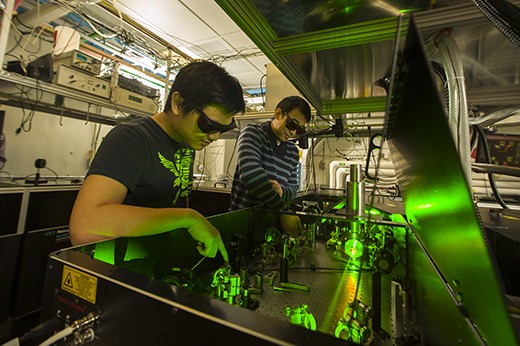
Sociology, Anthropology, and Social Work
Michael Wesch launched a new podcast, life101.audio, and was featured in the Chronical of Higher Ed and Total Frat Move. The Association of College University Educators also wrote a post about Dr. Wesch’s teaching.
Nicolette D. Manglos-Weber presented “The Globalizing Church and the Transnational Public Sphere: Inclusivity, Legitimacy, and Efficacy in a Pentacostal-Charismatic Organization” at the ASA Annual Meeting in Seattle on Aug. 22.
Nadia Shapkina presented two papers at national professional meetings in Seattle: “Sociology of Human Trafficking: Teaching about the Risks of Globalization” was delivered at Society for the Study of Social Problems annual meeting and “Anti-Trafficking Organizing in Russia and Ukraine: A Global Institutional Ethnographic Analysis” was presented at American Sociological Association annual conference. Dr. Shapkina also led a refereed roundtable on gender, sexuality, and identity organized by American Sociological Association’s section on sociology of sex and gender.
Chardie L. Baird, associate professor of Sociology, presented “Path Dependency in Full-Time Working Mothers’ Labor Force Pathways” at the Work Family Research Network (WFRN) conference in Washington, DC. Co-authors are Stephanie W. Burge and Ashley Wunder.
Laszlo J. Kulcsar, Joseph Aistrup, Thomas Bulatewicz, Jeffrey Peterson, Stephen Welch, and David Steward published “Water and Society: Interdisciplinary Education in Natural Resources” in the Journal of Contemporary Water Research and Education.
Laszlo J. Kulcsar, Nina Glasgow, David L. Brown, Scott Sanders and Brian Thiede presented “The Grey Frontier: Lived Experience in Extreme Aging Communities” at the Annual Meeting of the Rural Sociological Society in Toronto in early August. Return to top
Statistics
Mike Higgins was the lead author in a publication appearing in the prestigious Proceedings of the National Academy of Science (PNAS). The authors developed an algorithm for statistical blocking that is designed to improve the performance of massive experiments—such as those implemented at Google and Facebook. Experiments containing tens-of-millions of units can be blocked in minutes using a household computer. They showed that the algorithm outperforms heuristic methods that are currently applied to experiments of that size. They are now working on extending the algorithm to problems in statistical matching, prediction, and clustering.
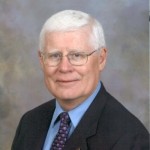 At this year’s Joint Statistical Meeting held in Chicago in early August, George Milliken received the W.D. Dixon Award for Excellence in Statistical Consulting. From the ASA Website: the award “award is given to a distinguished individual who has demonstrated excellence in statistical consulting or developed and contributed new methods, software, or ways of thinking that improve statistical practice in general.” George retired from K-State in 2007 after 38 years of service in the department, including serving as Department Head from 1985 to 1990. His consulting work dates back nearly 50 years to when he consulted with the sugar beet industry as a graduate student at Colorado State University. He is well known for his work in experimental design and messy data and has been equally well known as an effective mentor to faculty, graduate students, and researchers across multiple disciplines. Return to top
At this year’s Joint Statistical Meeting held in Chicago in early August, George Milliken received the W.D. Dixon Award for Excellence in Statistical Consulting. From the ASA Website: the award “award is given to a distinguished individual who has demonstrated excellence in statistical consulting or developed and contributed new methods, software, or ways of thinking that improve statistical practice in general.” George retired from K-State in 2007 after 38 years of service in the department, including serving as Department Head from 1985 to 1990. His consulting work dates back nearly 50 years to when he consulted with the sugar beet industry as a graduate student at Colorado State University. He is well known for his work in experimental design and messy data and has been equally well known as an effective mentor to faculty, graduate students, and researchers across multiple disciplines. Return to top
This was the first A&S newsletter I’ve ever received. I graduated in 1964 and was president of the A&S student council in 1963 (I think. . . it’s been a long time).
I suggest that the Journalism section offer a link to that department’s “Update” magazine. The recently published spring-summer issue was SPECTACULAR with its full page color cover of the Flint Hills by KSU grad Jim Richardson, a National Geographic photographer!!